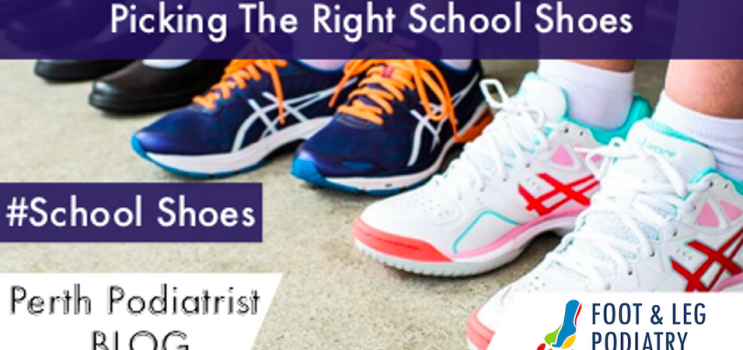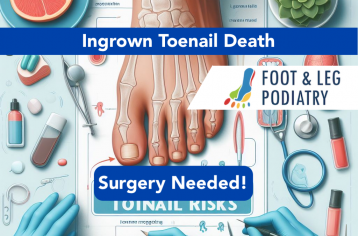
Perth Podiatrist FAQ Buying Kids School Shoes
February 27, 2019The Ultimate Guide to Buying Kids Shoes – A Podiatrist Guide.
Finding the right school shoes for your kids can be an absolute mission! Not only is the process tedious, but if you buy the wrong shoes – you’re risking the normal development of your child’s feet and potentially exposing them to serious injury. So how do you know you’re buying the right kids shoes? Today our Perth Podiatrist guide is going to walk you through the process step by step. First we’ll touch on shoe sizing and learn how fast children’s feet actually grow. Next we’ll uncover the 5 simple tips to ensuring you make the right shoe choice. So pay attention if you have kids, are considering kids or simply want to help your children stay active and pain-free in some decent shoes this school year.
Don’t worry childhood foot conditions and their associated pains can be quickly and effectively treated by our Perth Podiatrist at Foot & Leg Podiatry with 3 Perth clinics they’re easier than ever to find. If your child is walking ‘funny’ or limping and in pain, then isolating the presence of a childhood foot condition and beginning targeted treatment is paramount. Professional advice should be sought and our Perth Podiatrist regularly treats patients concerned about their kid’s feet and knee pains so you can rest easy knowing their knees and feet are in safe hands. An appointment at our podiatry clinic is only a phone call or web enquiry away and no referral is required, making it easier than ever to find a solution to your child’s developmental gait problems.
Disclaimer: This is simply a general discussion regarding kids shoes and common childhood conditions that often require treatment by our Perth podiatrist. Any advice & information is general in nature and not to be taken over the advice of a qualified medical professional or orthopaedic surgeon who is aware of your specific injury details. I hope this blog inspires your interest in the topic, so without further delay let’s find out more about picking the right shoes for your children:
What’s the Difference Between Shoe Sizes?
I’m shocked I’ve never thought to ponder this question but the difference is just 8.46mm for a whole shoe size increase, using the UK standard measurement, and naturally 4.23mm for a half shoe size increase. The below shoe size conversion table shows how shoe sizing changes depending on the country of sale.
How Does Foot Size and Recommended Shoe Size Compare?
Based on the above shoe size conversion table your recommended shoe size is roughly 15mm larger than the measured foot size allowing some wiggle room for your toes. This is about 3/4 my thumb width so likely why the thumb width rule discussed below has become popular.
What is Normal Foot Length Development?
The research into normal foot growth varies slightly article to article however they all agree that the average rate a child’s foot grows does depend on their age. Comparing three studies one (https://www.ncbi.nlm.nih.gov/pubmed/6832663), two (https://www.ncbi.nlm.nih.gov/pubmed/2307377) and three (https://www.ncbi.nlm.nih.gov/pmc/articles/PMC3034705/) I settled on the below dataset:
- From birth to 12 months = 4 mm per month or one shoe size every 2 months.
- 12 months to 4 years = 2 mm per month or one shoe size every 4 months.
- 4 years to 6 years = 1.4 mm per month or one shoe size every 6 months.
- 6 years to 8 years = unknown but assume 1.4mm or one shoe size every 6 months.
- 8 years to 9 years = 0.7mm per month or one shoe size per year.
- Girls: 9 years to 11 years = 1.4mm per month or one shoe size every 6 months.
- Girls: 11 years to 13 years = 0.7mm per month or one shoe size per year.
- Girls: 13 years + = Adult Foot Size
- Boys: 9 years to 10 years = 0.7mm per month or one shoe size per year
- Boys: 10 years to 12 years = 1.4mm per month or one shoe size every 6 months.
- Boys: 12 years to 14 years = 0.7mm per month or one shoe size per year
- Boys: 14 years + = Adult Foot Size.
Based on this data I came up with the ultimate child foot growth chart
So How Many Pairs of Shoes Would I Need For my Growing Child?
Too Many. OK if we tally up the above it totals to a minimum of 6 + (3 x 3) + (2 x 2) + (2 x 2) + 1 + (2 x 2) + (1 x 2) = 30 Pairs MINIMUM to the age of 13! That’s a ridiculous amount of footwear to need at a minimum for your growing kids, sorry parents…
Do Boy and Girl Feet Size Differ?
Yes research tells us that males of the same age need one size larger than females and hit their teenage foot ‘growth spurt’ roughly 1 year after females. Interestingly this rapid foot growth is roughly 1-2yrs before their teenage height ‘growth spurt’. It’s also important to note that foot length and width were shown to grow proportionally together at the same rate for both males and females.
What Age do Your Feet Stop Growing?
Based on the above research the average child’s foot stops growing at the age of 14. However technically your feet stop growing at the age of 22. I say technically because that’s the age your foot bones are usually fully ossified by. Before this age foot bones have a growth plate – think of it like a jelly substance, that can easily be deformed by external pressure (read inappropriate footwear).
What Happens if I Wear Shoes that are TOO SMALL?
Nothing good. Anytime before the age of 22 (and any age really), poor shoe size choices can affect foot health. That is, wearing a shoe that is too small for your growing feet for an extended period (read over an hour) can and will negatively affect the normal development of your feet as they are confined by the shoe. You only need to look back at images of Chinese foot binding victims to see the long-term effects inappropriately small footwear can have on your foot development. If you want to avoid needing our Perth podiatrist on speed-dial, then make sure your kids shoes aren’t too tight.
What Happens if I Wear Shoes that are TOO BIG?
Nothing really bad. In fact I’ve never seen a child in my Podiatry clinics with foot or knee problems caused by shoes that were too large for them. But that doesn’t mean it’s not risk free. Potentially wearing a shoe that is too large for your foot makes you more likely to be affected by blisters. Blisters are mainly caused by friction forces so shoes sliding on skin, however this can be remedied in many cases by simply wearing socks, or taping the affected toes/part of the foot. If you’re wearing massively too large shoes, then you’re likely to trip over the excess length – think clown shoes. In summary, larger shoes are safer, but don’t go buying shoes that are dramatically larger than your childs foot, unless it’s for a clown show.
Tip #1 Measure Their Foot Size:
We’ve established that the correct shoe size and fit is important but how do we measure shoe size on kids that have more in common with wiggly worms then sloths when it comes to sitting still. One fun way to try would be to make a game of tracing your feet with your child and comparing foot sizes, you could do this with paint if you don’t mind cleaning up afterwards, or with pencils on paper. Once you’re done, you’ll have a stencil you can use to place under the sole of shoes in store and buy the correct size from this. To ensure accuracy, you could place the stencil under old shoes so you’re comfortable it’s accurate. As an added bonus, the stencil will serve as a memento you can bring out at their 21st.
For teenagers, taking them to a shoe store with the promise of another 30mins internet time may be all the bribe you need for the store clerk to measure their foot length properly and try on comfortable shoes. At the end of the day all decent shoe stores will be able to measure your child’s foot size so you’re in the right ball-park from the beginning. Getting this right is an important step.
Tip # 2 Check Toe Clearance with Your Thumb:
When your child starts trying on shoes check that their longest toe (1st or 2nd typically) has a good thumbs worth of clearance from the end. This will avoid blisters and nail damage occurring as their foot slides forward in the shoe with each step.
Tip # 3 Check Forefoot Width with a Single Hand:
Bunions and crooked toes abound when shoes push or limit little (and big) toes from moving normally when you walk or run. Your hand squeezing over the front of the shoe should feel some space between the knuckles (metatarsal heads) of your toes and the shoe material. If there’s no give, then they’re likely too narrow and it’s time to move on.
Tip # 4 Eliminate Forefoot Crease Issues:
Modern upper material (everything that isn’t the sole of the shoe) these days are pretty forgiving in sport shoes, however the leather or pleather in school shoe can sometimes crease as children walk putting excessive pressure at the top of their toes. If this crease is a painful problem it’ll be quickly identified by an unhappy child – make sure they walk (or run) around the store to rule this shoe problem out. Unfortunately there’s no easy way around this one.
Tip # 5 Try a Few Different Brands:
Most brands have a variety of shoe types, but what is unique to each is their shoes last (shape of the shoe). In practice this means that each brand is going to be a different width at the front of the shoe compared to the rear. Some brand’s shoes are typically narrower, so are a better fit for narrow feet – eg. Nike & Addidas. Other shoe brands are typically wider, so are best for children with wider feet – eg. New Balance, Brooks and Asics. Try 3 different brands and see what fits your child’s feet best. And remember shoe brands specific shoe models can change their fit from year to year. Don’t think that because your shoes fit amazingly well last year that the same specific model the next year will fit perfectly again. Don’t be brand allegiant, always seek out a good fit.
What Should I Do If I Am Concerned About My Child’s Foot, Knee, Hip or Back Pain?
If your child does have a painful foot, knee, hip or even a back problem and are concerned that poor footwear could be the culprit then consulting a Perth Podiatrist who can expertly evaluate, examine and if the necessary image and treat your foot, knee, hip or back pain quickly and effectively will lead to your best outcome. An appointment at our Perth podiatry clinics is only a phone call or web enquiry away and no referral is required, making it easier than ever to find a solution to your childs pain – Today.
What are some Common Children foot complaints?
I’m glad you asked – you can read our Perth Podiatry blog about the 10 common children foot problems here.


